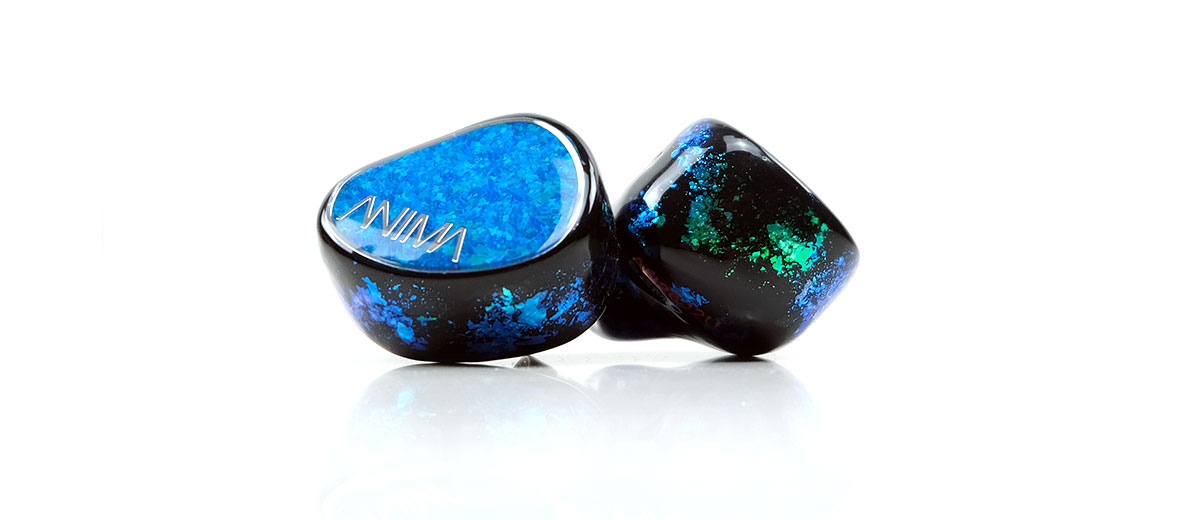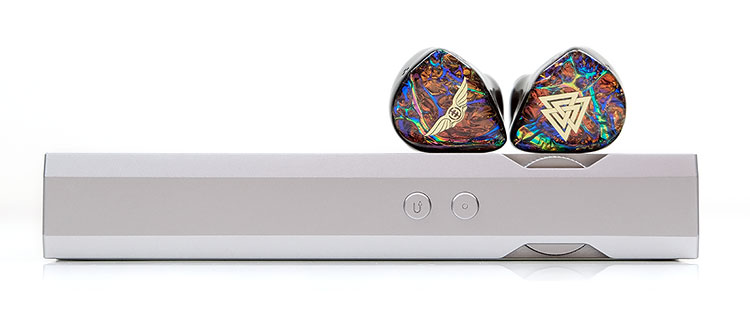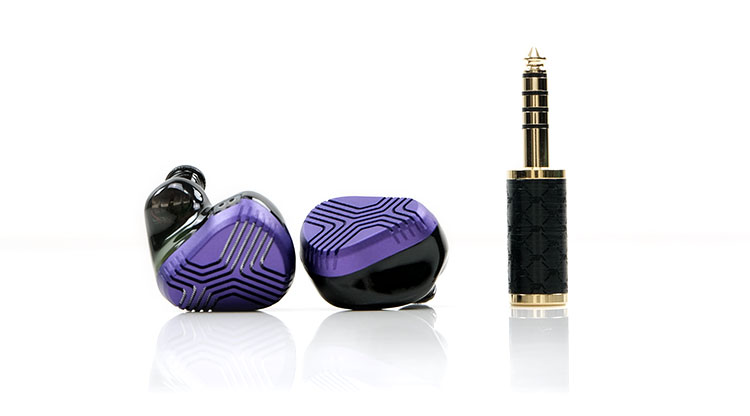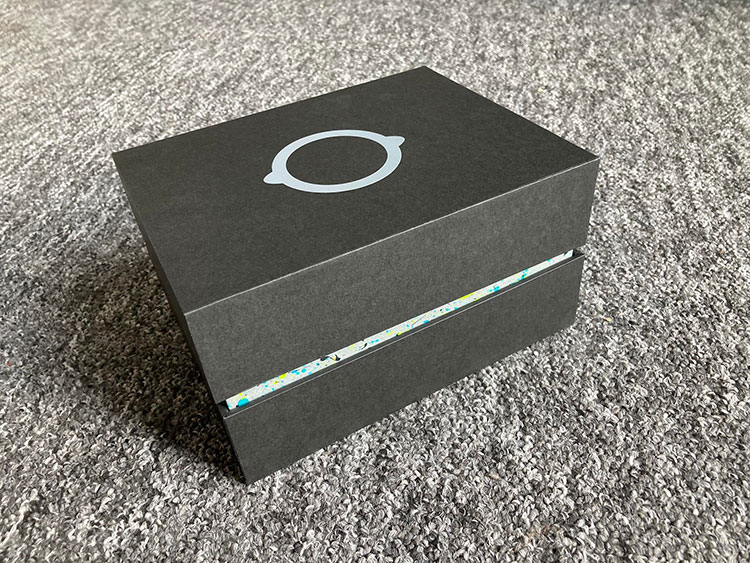Select Comparisons
All impressions were completed using SpinFit CP145 and sources including a Luxury & Precision P6 Pro, a HiBy RS6, and a FiiO M17.
Lime Ears Pneuma
Until the launch of the Anima, the Pneuma was Lime Ears’ flagship IEM and one which we reviewed back in late 2020. You can read more about it here.
€1800
Technical
The Pneuma was Lime Ear’s first hybrid universal IEM but in terms of raw driver count its 5 driver configuration is dwarfed by the 13 driver implementation inside the Anima. Not that this is the be-all and end-all but it is worth noting given the Anima is a fair bit bigger physically as a result.
Naturally, more drivers mean a different configuration for both but there are some similarities. Both use a single 7mm titanium diaphragm dynamic driver that targets the sub-bass frequencies and is aided by a dual BA subwoofer for the mid-bass response.
On this basis, there is some similarity. However, the Anima is more precise with the BA’s phasing into another two BA drivers covering the 120Hz to 300hz frequency range for the mid to upper bass response. The Pneuma’s 2 BA’s cover the same range as these 4 drivers.
The differences continue through the mids with the Pneuma using a single BA for the mids and another for the highs with a 4-way crossover. The Anima throws in 2 BA for the mids up to 2.4K and another 2BA up to 10k. This is then topped off with a quad-electrostatic driver pack for everything beyond 10k using a 6-way crossover.
Other significant differences include the use of the newly designed organic horn nozzle on the Anima which builds on the VariBore tech inside the Pneuma’s regular tri-bore spout as well as the lack of Bass switch. I think this is the first time I have reviewed a Lime Ears IEM without the bass switch system.
Design
Again, some of the design between these two is a shared language with the deft use of those reflective flakes on the shells giving both a nice turn of color under certain lighting conditions.
The Anima I guess is more in vogue with the Lime theme with its stronger twist of green under the light. It is also the more premium finish with those stunning Bello Opal particle finishes on the plates whereas the Pneuma has that “sacred geometry’ symbol in white print as its plate.
Size-wise the Anima is by far the bigger and you can detect the bulkier funnel to the nozzle also which I presume is to provide additional space for the electrostatic drivers. The Pneuma is lighter, sticks out of your ear a bit less, and has a little more pinch in a thinner nozzle.
Neither is vented, you do not need a vent really for a 7mm diver unless you have a tiny acoustical opening. That means above-average isolation for a hybrid and indeed both have a similar feel in terms of good comfort and isolation.
Cables differ also. I am quite partial to the PW Audio No 10 with the Pneuma, it’s good quality but slightly warm sounding 24AWG single crystal OCC SPC wire.
The new stock cable is still SPC though it is measured by strand count rather than by wire with 144 graphene-coated strands. It does have that beautiful Viking Weave splitter and chin cinch though which makes the No 10 look a lot plainer.
Performance
The Anima doesn’t deviate too much from the Pneuma FR bias in terms of bass and vocal emphasis rather it gives you a lot more as well as introduces improved treble presence and coloration.
There is a clear gap between the technical performance of these two with the Anima sounding more resolving, articulate, and with better dynamic range.
How to best describe this in layman’s terms? Say you compare two IEMs and you keep turning up the volume on one but it never seems to match the volume of the other? That’s the dynamic range gap for me. The Pneuma sounds relatively compressed which is a feat in itself as I loved the Pneuma when I reviewed it.
The Pneuma also sounds more rounded and slightly warmer. There is a rise from 7-10k in the Anima tuning that brings out a lot of subtle spatial cues that the Pneuma does not shine a light on nearly as well. Beyond that, you can detect those e-stat drivers providing the final stretch which gives the Anima so much more headroom.
Mids timbre has a bit more of an odd harmonic lift on the Anima compared to the denser rounded timbre of the Pneuma. Both have forward-sounding mids with raised 1-4k FR curves but the Pneuma doesn’t have the same treble headroom and slightly less 4-5k presence so it loses a bit of comparative separation and air around vocal performances.
Of course, I suspect some might like that earthy tone of the Pneuma, and it can sound more robust through the lower mids. The Anima is a bit flatter through the 200Hz to 1k range compared to the Pneuma with the bass boost on. Turn it off and you lose that stronger fundamental and plenty of bloom from the Pneuma.
Empire Ears Odin
The Odin is our award-winning universal IEM from 2020 with a similar price point to the Anima as well as a similar tribrid configuration. You can read our review on it here.
$3399
Technical
Both of these flagship monitors are just stuffed full of interesting tech. Both are tribrid driver configurations with a headcount in double digits. The Odin uses 11 with a dual 9mm Weapon IX+ woofer setup for the lows, 5 balanced armatures with 2 dual-driver units for the lower mids and the mids, and a single BA driver for the mid-highs.
The Anima uses a smaller 7mm titanium diaphragm dynamic driver purely for the sub-bass, 2 BA for the mid-bass up to 120Hz, and 2 more BA for the upper bass to 300Hz. It then uses 4 BA for the mids, 2 vented BA up to 2.4K, and another 2BA up to 10k.
Both complete their driver count with a quad pack of 2nd gen Sonion electrostatic drivers but here Empire Ears have combined both the highs and the ultra-highs whereas the Anima pack of 4 aimed purely at the ultra-highs.
Both of these bad boys have very complex crossovers as you can imagine with the Anima using a 6-way and the Odin going even further with its 8-way synX crossover combined with their Empire Intelligent Variable Electrostatic Control or EVIC for managing those stat drivers phasing.
Other notable highlights include differing approaches to acoustical fine-tuning including the unique acoustical design of the organic horn nozzle for the Anima and the Anti-Resonance Compound or A.R.C inside the Odin special type of damping coating used on the inside of Odin’s shell to hammer down on resonance.
Design
Both designs have color pop, but the visual on the Anima is all over the shell whereas the Bifrost Dragonhide design is strictly confined to the faceplate. The rest of the shell is their standard opaque onyx acrylic hollow-body build.
The Anima splits it between the Bello Opal particle plate design and the collage of reflective blue/green flakes on the body. It is a more comprehensive and unique design approach though I still rate the Bifrost as a very cool plate design.
The Odin is smaller and lighter, however. No getting around the size of the Anima, in part due to the tubeless acoustical spacing for the electrostatic drivers creating that thicker nozzle funnel but also 2 additional drivers might push up the demand for space.
As such the Odin has a lighter presence in your ear compared to the Anima and is slightly the more comfortable of the two. Note, driver flex is a thing with the Odin though just the once when you insert.
The Anima has no venting with that smaller 7mm driver whereas the Odin needs that triple vent for the dual 9mm Weapon IX+ design. That means the Odin has a slightly lower level of isolation. I do love the Final E tips with the Odin, however. I hope the Anima does ship with those alongside the SpinFits. Only time will tell.
For cables, the Viking Weave adorned 144-strand SPC cable of the Anima is impressive but the Stormbreaker is pure pedigree being a modified PW Audio 2-wire 1960s cable. It is lighter, thinner with plenty of shiny bits and bobs, and just as quiet and easy to manage.
Performance
In terms of technical ability, this is a competitive comparison with some excellent resolution, a very high level of dynamic range and yes, both FRs are tuned with a forward 1-4k upper-mids performance.
However, the final sound signature or coloration is not quite the same. If anything, the Anima is like the more ‘chilled’ version of the Odin. It has some excellent depth but not quite the same force and aggression at the sub-50Hz level as the dual Weapon XI+ woofers inside the Odin.
However, the instrumental body through the mids-bass and upper bass is a bit more substantial on the Anima giving its lows some additional warmth. This is an area that tends to be thinned out a bit more on the flatter FR of the Odin though it does enhance the perception of some excellent bass to mids separation.
I did say the 1-4k was pushed on both, however, the Odin is the more elevated of the two. Vocals are much more immediate and upfront, whereas the Anima vocal imaging is comparatively more relaxed in its positioning.
The Odion also has that little 5k bump and can pick up an edgier tone with brightly mixed tracks over that 3-4k area but beyond that, it levels off quite smoothly until about 8-10k. The Anima dips a lot more from 5-7k for me and injects a little less energy here. You get more of an ethereal shimmer from 8-10k onwards and slightly less lower-treble presence and physicality with the Anima.
Vision Ears EXT
The EXT was launched in the last quarter of 2021 and it was an award-winning IEM for the same year also. You can read our thoughts on this high-end monitor in more detail here.
€2650
Technical
The EXT is a very different electrostatic hybrid from the Anima. For a start, it has completely done away with BA drivers and instead offers a dual dynamic driver and a quad electrostatic configuration or 6 drivers in total.
The EXT dynamic drivers are different sizes and cover the lows to the mids. VE has used a 9.2mm dynamic driver for the low-end and a smaller 6.2mm dynamic driver for the mids with the quad electrostatics covering the highs and the ultra-highs. That’s quite a bit simpler than the 7mm dynamic, quad BA for the lows, and another quad pack for the mids for the Anima.
Both do use a set of 4 Sonion electrostatic drivers for the highs, both powered by those 2nd gen Sonion energizers which give them a bit more efficiency than the original versions a few years back. Like the Odin, VE has brought the coverage down into the highs and not just the Ultra highs which are where the Anima electrostatic focus is.
Acoustics play an important role inside both IEMs. VE has fine-tuned the mids dynamic driver inside their 2nd gen HALC acoustical chamber by adding an STC or side tuning chamber alongside the original leveling chamber of the HALC. This is primarily to give the EXT vocals a bit of a lift and focus.
The Anima’s acoustical prowess is via a tubeless electrostatic internal design combined with the organic horn nozzle and strategic positioning of the exit bores within the recessed horn.
Design
Goodness tiny meets large, no two ways about it, the EXT is petite compared to the Anima. Admittedly, it only has 6 drivers to fit into its shell but even so, it is a compact low-profile monitor with far less weight by any standard.
Aesthetically, they are also on different paths with the Anima all blinged out with a jewelry design language using that Bello opal particle faceplate combined with the reflective blue and green flake finish on the acrylic shells.
The EXT is more mech-style with sharper lines, grid visuals, artistic slashes, and a deep monolithic purple finish to the CNC machined aluminum faceplate. It is more understated but quite modern in its appeal.
Personally, I think the nozzles on both are two key talking points here. The EXT has an almost 90-degree angle on the nozzle bend. The shape is basically designed not just for a deep insertion to get as close as possible to the second bend in your canal but to create an almost flush fitting in the ear similar to a custom.
The Anima nozzle is all about that acoustical funnel internal design to its horn with the strategically placed bore exits. The external diameter is more of a classic straighter nozzle so it fits in a traditional fashion but sticks out a bit more.
The tips play a huge role with the Anima sound signature and whilst they can color the EXT tuning it’s not to the same radical extent as with the Lime Ears design.
Comfort-wise no question the EXT is the lighter lower-profile fit and whilst the Anima isolation level is very good without a venting port to worry about, the EXT just edges it for me with that angular nozzle hugging my canal tightly.
Performance
In terms of dry FR comparisons, the EXT has a gentle V-shape with a powerful and robust bass performance, a natural but controlled 1-2k bump for vocal balance, and some nice electrostatic shine from 6-8k. The Anima is more w-shaped with a stronger 1-4k mids to upper-mids focus and a peppy 8-10k rise and beyond that creates some nice sparkle and air.
The Anima easily competes with the EXT both in terms of punch and top-end extension. Beyond that, the upper mids bump is more pronounced with a bit more of an odd harmonic lift in its timbre that gives some additional perceived clarity and presence to the Anima vocals. If anything, the Anima will capture your attention first with that sparkle and upper-mid presence.
However, the EXT is the smoother of the two and perhaps offers the more natural timbre with that coherent dynamic driver texture from the lows through to the mids. You can detect and hear the difference in the note body once you move into the mids with the Anima sounding a little lighter though to be fair a bit nippier.
For bass, I have to give the edge in terms of physicality and density to the larger EXT 9.2mm dynamic driver. It sounds slightly richer and more textured than the two sub-50Hz. Both have excellent PRaT but for sheer weight, right at the bottom, the EXT sounds heavier.
The Anima 7mm driver does well though especially in terms of layering. You could argue its competitive edge comes from those mid-bass BAs offering a tighter punch and less upper-bass bloom. In turn, combined with that more forward midrange imaging, the Anima vocals have more energy and a sweet tone with room to breathe but slightly less body also.
Our Verdict
I think it is safe to say we can welcome Lime Ears to the big boys’ playpen with the launch of the new flagship Anima. They hinted at this type of performance and build quality with the Pneuma a few years back and in some ways the Anima takes some of the theories first realized in the former flagship to the next level and then some.
This is a monitor with balanced yet joyful tuning with a deep resonating bass performance and almost ethereal highs and plenty of headroom from those e-stat drivers. It competes well with other hybrid electrostatic standard-bearers such as the Odin and the EXT but is unique enough to set it apart as a viable alternative on your shopping list.
One caveat is the tip selection, you will find it is quite sensitive to what you put on that pure silver organic horn nozzle. I have my preferences and I am sure you will have yours also but I promise you a different performance with every different choice.
Since the audio trade shows are alive and kicking this year and Covid is losing its fear factor I do strongly suggest you demo the Anima if you are in the market for a high-end monitor. It’s another very credible choice on the ‘money no object’ table.
Lime Ears Anima Specifications
- 7mm Titanium Dynamic driver, 8 Balanced Armature drivers, 4 Electrostatic drivers
- 1DD infra-sub, 2BA sub, 2 BA low, 2 BA mid, 2 BA high, 4 EST superhigh
- Crossover: 6-way, hybrid
- 5Hz – 40kHz (theoretical)
- Sensitivity 112dB
- Impedance 16Ω





